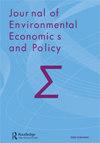全面经济贸易协定(CETA)和空气污染
IF 1.2
Q3 ENVIRONMENTAL STUDIES
Journal of Environmental Economics and Policy
Pub Date : 2021-01-26
DOI:10.1080/21606544.2021.1877199
引用次数: 1
摘要
摘要本研究实证调查并表明,平均而言,全面经济贸易协定(CETA)的实施可能有助于对抗全球变暖。这项研究发现,平均而言,加拿大与一个典型的欧盟成员国之间的双边贸易额每增加1%,作为GDP的一部分,就可以帮助一个典型的CETA成员国平均减少约0.57%的年人均温室气体排放量。结果还表明,CETA的存在可以降低几乎所有CETA成员的人均温室气体年排放量。无论本文采用何种模型或统计方法,都没有统计学上显著的证据表明CETA成员国的人均温室气体排放量有所增加。这些结果之所以成立,是因为结合了要素禀赋假设(FEH)、基于人口密度变化的污染避风港假设(PHH2)和基于国民收入差异的污染避风港假设(PHH1)。本文章由计算机程序翻译,如有差异,请以英文原文为准。
Comprehensive Economic and Trade Agreement (CETA) and air pollution
ABSTRACT The study empirically investigates and shows that on average, the implementation of the Comprehensive Economic and Trade Agreement (CETA) may contribute in the fight against global warming. This study finds that on average, a 1 percent increase of a percentage point in the bilateral volume of trade as a portion of GDP between Canada and a typical EU member could help reduce annual per capita emissions of GHGs in an average CETA member by about .57%. The results also show that the presence of CETA may decrease annual per capita emissions of GHGs in almost all CETA members. There is no statistically significant evidence suggesting an increase of GHGs per capita emissions in any CETA member, regardless of the model or statistical method employed in the paper. These results stand because of the combinations of the factor endowment hypothesis (FEH), the pollution haven hypothesis based on population density variations (PHH2) and the pollution haven hypothesis based on national income differences (PHH1) between each EU member and Canada.
求助全文
通过发布文献求助,成功后即可免费获取论文全文。
去求助
来源期刊

Journal of Environmental Economics and Policy
ENVIRONMENTAL STUDIES-
CiteScore
4.70
自引率
7.70%
发文量
26
 求助内容:
求助内容: 应助结果提醒方式:
应助结果提醒方式:


